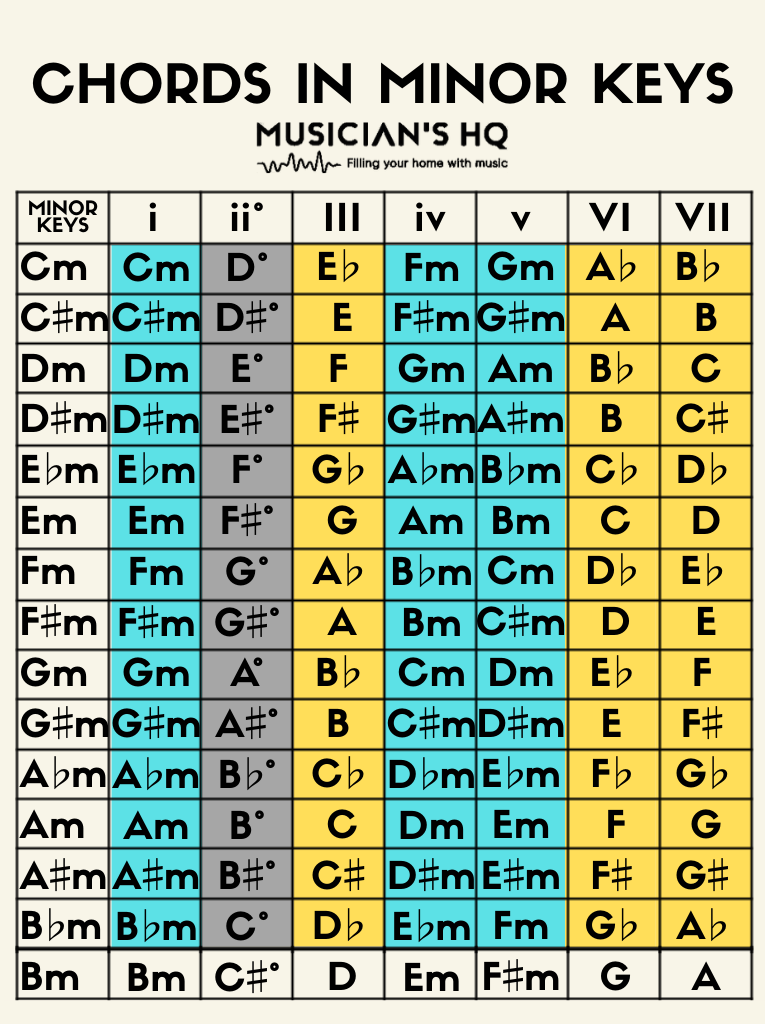

The same rules also apply for chord substitutions. If you want to use this concept in another key, simply more the Minor Scale shape to a new root note, work out the notes and then apply the same chords to each interval of the new position, and now you can play chord progressions in any Minor key. There are a few examples of minor key chord progressions in action in the attached video. If youre playing guitar, the keys with the easiest chords are G major, E minor, C major and A minor. As with the Major, there is a set chord for each of the 7 degrees of the scale. Next, pick a key that you feel comfortable playing in. Once you know the notes, you can apply chords to each note. This gives you A B C D E F G which are the notes of the A Natural Minor scale. In the key of C minor, this progression would be Cm to Ab to Fm to G to Cm. You’ll notice the C# becomes a C, the F# becomes an F and the G# becomes a G. The VI chord in minor keys is a major chord. This gives you a new note and interval structure compared to the A Major Scale. Now chords of any key are reduced to seven Roman numerals. The only different chord that we showed earlier and did not appear in this table is the dominant one in the II V I progression for minor chord. Minor chords are denoted by lowercase characters, major chords are denoted by uppercase characters. For example, our harmony will look like i VI iv V. The notes that need to be flattened are the 3 rd, 6 th and 7 th degrees of the scale. Therefore, many musicians began to designate chord progressions with Roman numerals, step by step. To flatten a note, you simply lower it’s pitch by a semitone. Chord progressions like the 12-bar blues can be found all over popular music. The sequence of chords in minor keys has the same types of chords as majors but in a different order. To turn your major scale into a minor scale there are a few specific notes that need to be flattened. Your chord progression in A minor would look like this: AmBdimCDmEmFG. This principle can be applied in any key. Using the A Major Scale, you can make a few amendments which will create a Minor Scale. Now that we know the shape, we need to know the notes of the scale and give each one a number, known as an interval: I This scale is a gateway into understanding theory and also allows you to create other theoretical concepts.

To start off, you’ll be referencing the A Major Scale. Writing Your Own Minor Chord Progressions 7. The Top 3 Chords in Minor Progressions 5. In this lesson you’re going to look at the Natural Minor scale and learn how you can use this scale to write chord progressions. enough listening practice, you’ll be able to recognize minor chord progressions in songs almost instantly Table of Contents: 1.
Minor chord progressions how to#
Now that you’ve started to learn how to write songs using Major Chords from the Major scale, it’s time to flip things around to Minor. Fantasy Chord Progressions I, i,II, ii, III, iii, III, IV, V, V +, VI, VI, vi, VII, vii ( I is tonic/root ) Extensions a major or minor third. How to Write Minor Key Chord Progressions


 0 kommentar(er)
0 kommentar(er)
